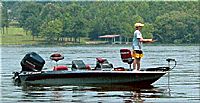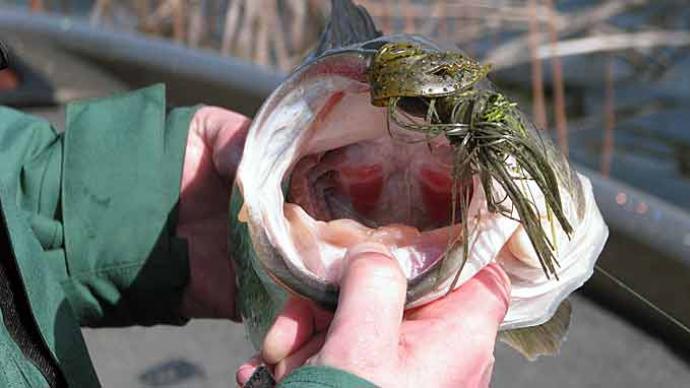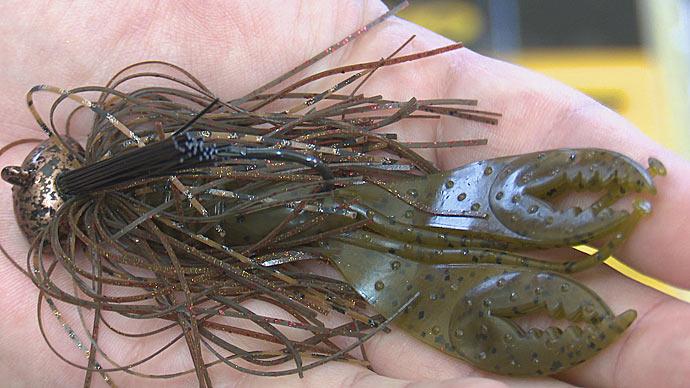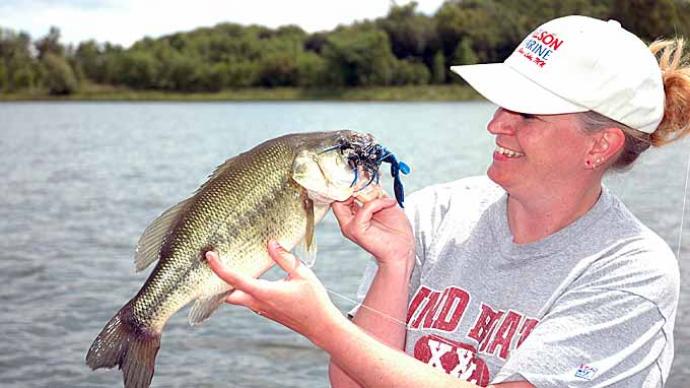
Jigs can be fished anytime throughout the year and are almost always productive. Jigs are known as the "big money bait" on the top tournament trails. They are the most versatile lures ever known to man. Jigs can be flipped, pitched, hopped, swam, and used as a weight on a drop-shot rig. Endless possibilities! Jigs catch the elusive largemouth bass to the deep-water Kentucky spots and the diehard smallmouth bass. With a bit of practice, a jig can be an excellent weapon for the beginner and the advanced angler.
General Tackle For Jig Fishing
When flippin' and pitchin' in shallow water cover, I like to use a Daiwa Tatula reel with a heavy action 7' 6" Daiwa Tatula heavy flipping rod. Remember that in heavy cover, you need to set your drag tight to get the fish out as quickly as possible. For heavy cover, I like Strike King's line of jigs. They have a strong Mustad hook and a broad head to prevent hang-ups. I use Seaguar TactX 30-pound braid line when flippin' and pitchin' in the tough stuff.
When fishing in open water, I use 20-pound Seaguar TactX. I choose line color according to the surroundings, water clarity, and weather conditions. I tie a Uniknot on all my jigs.
When fishing a jig as a weight for a drop-shot rig, I use a Daiwa Tatula spinning reel with 8-pound Seaguar BasiX fluorocarbon line.
Make sure you buy a good quality reel when purchasing a rod and reel. I look for at least four stainless steel ball bearings and an excellent anti-reverse system. When choosing a rod, I go with a rod at least 7 feet long.
Pre-Spawn Jigging
When choosing a pre-spawn jig, I prefer a ½-ounce Strike King Pro-model jig. I choose my weight according to the depth at that I will be fishing. I like red, brown, or pumpkinseed to resemble a crawfish.
I like to fish submerged weeds in about 8-12 feet on secondary points. This is where the bass are staging to move in to spawn. That is why they call it the pre-spawn. I like to swim my jigs at this time of the year. I swim my jigs just on the top of the weedline, trying to touch a few weeds in the process and then breaking free. This is when most of the strikes will occur. So it is just a balancing process.
Cast your jig to the bank and retrieve it from shallow water into deeper water. Choose a jig size so the jig will brush the tops of the weeds. If you are getting too many weeds, either speed up your presentation or go with a lighter jig. If you aren't getting the depth you want, go up a little in weight.
When I swim my jigs, I always use a plastic crawfish-type trailer. I like to use a Strike King Rage Craw, or Big Bite Baits College Craw, using the bottom half of the lure. I cut the lure just above the bottom flaps. These flaps are essential. They give you the necessary action to encourage a strike, especially in muddy water conditions.
As for scents, I like to use Bang's crawfish formula.
Follow the bass as the days go by as they move into shallower water to spawn. You probably won't find bass schooling up much when they start to move in to spawn. But when you find a bass, it will probably be huge.
Jig Fishing During The Spawn
Ahh! My favorite time of the year. Nothing is better than seeing the fish on the bed and flippin' right to it. Bass hate to see a crawfish there because they know that little old crawfish is looking to pick off a nice meal.
For most of the spawn, there will be two fish on the bed, male and female. The males will first move in to make the nest. Then the females will come in to select the nest they think will have the highest success rate for the fry. After the female lays her eggs, she leaves, and the male guards the fry for 4-7 days. Remember that during the spawn, bass will tend to grab the bait for a brief moment, try to crush it, then spit it out. So feeling your rod and line watching are both very important.
Some ask, "What is the ideal spot for a bass to spawn?" The first place to look is in the back of a bay. This bay must be protected from thrashing water and be pretty calm. A bass will choose a spot according to the bottom contents and how many hours of sunlight the spot gets each day because eggs need light and warmth to hatch. Bass like to spawn in shallow water right next to deep water, just in case they need to flee to safety. I also look for some cover in that deeper water - it's usually a post-spawn location where a bass regains its strength after spawning.
Post-Spawn
Bass tend to suspend at this time of the year. When I fish the post-spawn, I swim the jig over cover in about 8-12 feet of water. I like to line up the secondary point with the mid-depth cover, and then I can usually find the general location of the bed. When I swim a jig, I use a 7' medium heavy rod with a 6:2:1 gear ratio Tatula reel. The 15-pound BasiX line is my favorite because I can detect bites better. I use a 1/2oz Strike King pro-model jig with a Strike King Rage Craw. I always use scents when swimming a jig.
To swim a jig, put your rod tip at the 10 o'clock position and use short but rapid jerks. I space these jerks by pausing, reeling up the slack, and then jerking again. This retrieve gives the trailer a flapping motion.
I detect my bites by feeling the jig more than sight. So when I am retrieving the jig, I feel the bite, take one more jerk, reel up the slack, and set the hook HARD! Bass seem to slam that jig when it is being swum.
You may have to experiment a little to find the depth of the suspended bass. Sometimes just bumping it into the cover will draw the strike. But be sure to fish the bait above or through the suspended bass, never below.
Summertime Jigs
During the summer, jigs can be fished throughout the day and into the night. However, mornings can be a very successful time to swim a jig.

Bass may be located on long, main-lake points, submerged weeds, humps, and roadbeds. When swimming a jig on a point, start fishing the shallow part of the point in the morning. As the day moves on, move out to deeper water. Then, try to fish the shady side of the point when the sun is shining.
Submerged humps are also very successful places to fish in the mornings and afternoons. The bass are chasing shad and using the hump as an ambush point. Also, fish the ditches on the old roadbeds.
Stay away from conductors of heat. When I say conductors, I mean shallow riprap, black floats on boat docks, and old junk like refrigerators, cars, tires, etc.
When the water rises, largemouth will move up as shallow as possible into that rising water - following the fish into the shallow cover. This is an ideal time to flip and pitch a jig. Use bulkier baits, rattles, and scents because the water will typically be muddier when the water rises. Bass will start moving back into deeper water as the water level goes down.
It is a good idea to look at your shoreline surroundings while fishing at normal lake levels to find critical locations for fish when the water rises. The best points to look for are ones with the main channel running parallel to them.
When most people hear of channels, they think of noisy boats running through while they are fishing. Don't worry about that. That stirs up plankton, invigorates the food chain, and makes the bass crazy.
A great summer tactic is flippin' to busy boat docks where the boats stir up the plankton. This also occurs when boats are being launched at the ramp. Docks are great places to fish year-round. In the summer, it must be made of wood and close to deep water. Docks are bass magnets.
When fishing streams with jigs, look for breaks in the current. And ALWAYS throw your bait upstream and let it come back downstream. You will have greater sensitivity while fishing upstream. Most of the time, bass will face upstream, looking for a bait that passes along.
Fall Jigs
One of the most overlooked usages of a jig is swimming it. When you swim a jig, the best color is white. White is one of the closest colors to resemble a baitfish. Next, I match the size of my jig with the available forage. I use a Strike King Pro-Model jig in 3/8oz. Most of the time. But don't be afraid to go larger. I also team up my jig with a Big Bite Baits College Craw for 1/4oz jigs.
The best I've ever done with jigs in the fall is 20 pounds in 5 fish in 5 minutes. When you swim a jig, it is a rush. You never know when a fish is going to slam it. I fish my jigs around boat docks, main lake flats, creek channels, humps, and creeks in the fall. In the fall, a large portion of the bass will be located on the grass that is still living. So search for green grass, and you could fill the boat.
Winter Jigs
I like to fish small jigs in the wintertime. When I'm talking about small jigs, I mean about 3/16-1/4oz in size. I like to use the Strike King Bitsy flip. It doesn't come with a rattle. But that is good because, in winter, I believe that a rattle can spook a fish.
Remember that in winter, a bass's metabolism decreases. This means that bass will feed about one every three days. Therefore, it takes three or more days for a bass to digest its food in most lakes.
It's no secret that bass relates to wood in the winter. There is just some reason why bass are attracted to it. Maybe because crawfish and other forage live and hide here. Maybe because it retains heat longer in the winter.
Bass also relate to sharp breaklines. They like these because they don't have to travel far from deep to shallow water.
In addition, bass like to hang around docks with black floats and rocks because they retain heat well. Don't overlook tire reefs, as they retain heat as well.
Confidence
You must have confidence in yourself and your tackle that you will catch a fish on every cast. You'll catch a lot fewer fish if you don't have confidence.
Well, I hope I helped a few people learn how to be better bass anglers to enjoy their time on the water. And remember to wear a life jacket when running an outboard because the safe way is the best.
BassResource may receive a portion of revenues if you make a purchase using a link above.




